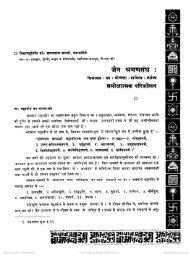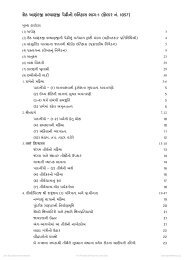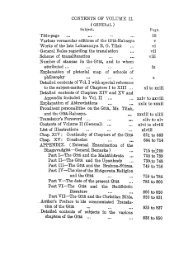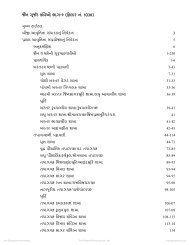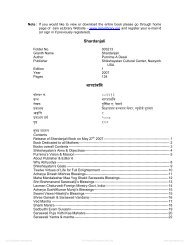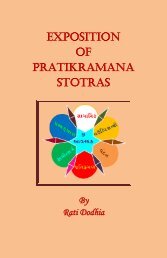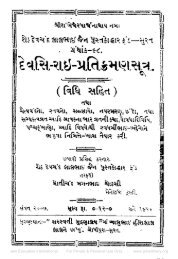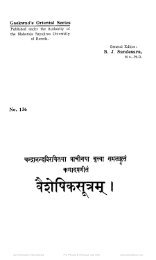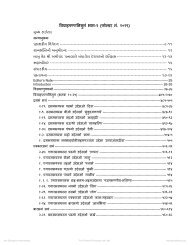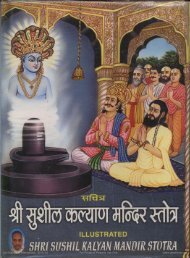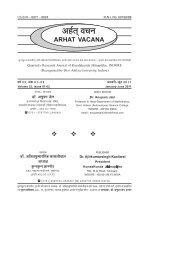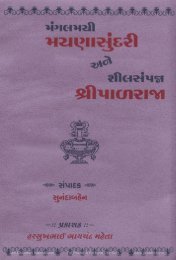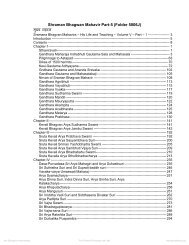Chapter - 08 Bon Po Religion - Jain Library
Chapter - 08 Bon Po Religion - Jain Library
Chapter - 08 Bon Po Religion - Jain Library
You also want an ePaper? Increase the reach of your titles
YUMPU automatically turns print PDFs into web optimized ePapers that Google loves.
Shri Ashtapad Maha Tirth - II<br />
In ancient times the Tibetans believed that by intervening in nature and altering the original<br />
harmony man could disturb the energies or 'deities' tied to various environments and that the<br />
ensuing disharmony could provoke a decline in his health and prosperity. The <strong>Bon</strong> <strong>Po</strong>'s were<br />
special ists in identifying the causes of the disturbances, through divination, astrology etc.<br />
and in prescribing suitable remedies which in most cases consisted in rites, according to this<br />
tradition the main means of restoring cosmic and individual harmony. Understanding in our<br />
own time the value and significance of these rites means opening a door onto the immense<br />
panorama of the primordial experiences and knowledge of man because, as the great scholar<br />
Mircea Eliade suggested at the conclusion of his study of Australian religions “The ultimate<br />
goal of the historian of religions is not to point out that there exist a certain number of types<br />
or patterns of religious behaviour, with their specific symbologies and theologies, but rather<br />
to understand their meanings.”<br />
In our era we have witnessed the disappearance of values and tradi tions based on civilizations<br />
thousands of years old, and nowadays man seems to have forgotten that part of himself which<br />
formed the essential nucleus of the myths and rites of ancient peoples. For this reason the<br />
danger of extinction of a culture tied to ancient traditions, as the Tibetan tradition is, means<br />
the loss of a knowledge that belongs to all of human ity, as it is part of that original wisdom<br />
or global vision that we find in various forms in all the religious cultures of the world.<br />
In my translation of the original Tibetan and in my edition and annotation I have enjoyed<br />
the generous collaboration of the author, who was my Professor of Tibetan at the Istituto<br />
Universitario Orientale in the University of Naples, where he currently holds the chair in Tibetan<br />
and Mongolian Studies. With unsparing patience he went over the whole translation and helped<br />
me resolve several doubts and difficulties, particu larly in the interpretation of passages from<br />
ancient ritual texts which frequently contained terms and expressions that have disappeared<br />
from modern Tibetan and are not to be found in the Tibetan dictionaries currently available.<br />
Heartfelt thanks are also due to Lobpon (slob dpori) Tenzin Namdak (bsTan 'dzin rnam dag), a leading<br />
exponent of <strong>Bon</strong> from Menri (sMan ri) Monastery in central Tibet, who during his stay in Italy<br />
in August 1989 clarified aspects and characteristics of the ancient ritual traditions for me.<br />
Finally I wish to thank Geshe (dge bshes) Tenzin Wangyal (bsTan 'dzin dbang rgyal), a young <strong>Bon</strong> <strong>Po</strong><br />
scholar currently living in the west, who helped me resolve certain doubts in the translation.<br />
Adriano Clemente.<br />
May 1991<br />
Drung, Deu and <strong>Bon</strong><br />
388



